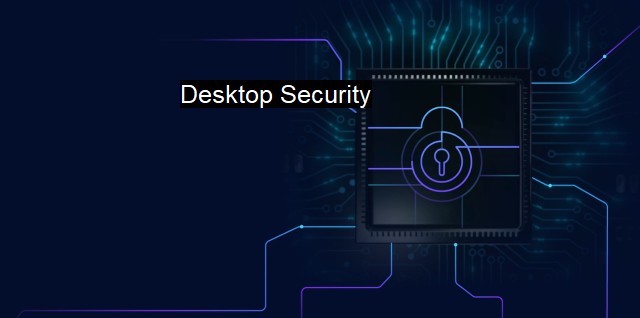What is Desktop Security?
Desktop Security: Safeguarding Computer Systems From Cyber Threats with Antivirus Software and Firewalls
Desktop security is a crucial aspect of cybersecurity that concerns safeguarding desktop systems from various forms of attacks. It largely revolves around implementing several measures to protect a computer desktop from undesirable software, unauthorized users, cybersecurity threats or damages to the hardware or software.In a broad sense, the term "desktop security" refers to measures and controls that are set to protect the desktop computing environment, including software, data, applications, networks, and hardware components. It is an encompassing term that involves strategies to prevent unauthorized access, protect sensitive information, and detect any malicious threats, thereby securing the integrity, confidentiality, and availability of the system's critical resources.
The significance of desktop security cannot be understated today, especially with the ever-increasing sophistication and volume of cyber threats. The devastating consequences of these threats include potential exposure of sensitive information, intrusion of privacy, loss of data, and productivity issues arising from system failures.
There are myriad technologies, practices, and strategies to ensure robust desktop security. an instrumental part of it entails employing antivirus or anti-malware software. This software is designed to detect, prevent, and remove malicious software, colloquially referred to as malware. It works by continually scanning the system for known threats. Upon detection of any potential virus, the antivirus software isolates and removes them from the system and repairs any damage that may have been caused.
While antivirus programs form an integral part of computer desktop security, it is imperative not to overlook other security measures. Effective desktop security also involves proper access and control, which logically limits and modulates who and how the resources in an operating system and applications are accessed.
The principle of least privilege can significantly enhance desktop security by ensuring that users or programs process minimal access rights necessary for their task execution. This approach is particularly useful in mitigating potential damage from malware or hacking attempts, where an unnecessary level of access could connote higher risk potential.
a strategy known as sandboxing can confine the execution of untrusted programs, preventing potential system infections. Sandboxing operates by furnishing an isolated and safe environment for a program to run, without posing a risk to the system's integrity.
Regular updates are also indispensable for maintaining desktop security. Updates act as a protective wall against malicious threats by patching vulnerabilities that attackers may otherwise exploit.
While strategies to maintain desktop security continually evolve, so does the nature of cyber threats. Phishing, ransomware, and different forms of malware can bypass even the most sophisticated antivirus programs. Therefore, user education plays a critical role in effective desktop security and involves guiding individuals on safe online behavior and correct responses to potential risks.
Desktop security forms an integral part of cybersecurity, instrumental in preserving system integrity, data protection, and overall user safety. From antivirus software to regular system updates, secure user practices, and principled access control, desktop security is a multifaceted approach that demands consciousness and consistent action in the face of growing digital threats.
Securing individual desktops constitutes an essential line of defense in the broader cybersecurity sphere. The ability to ensure robust desktop security contributes widely to advocating a safe digital environment, reflecting an increasingly interconnected digital landscape's demands. the focus on desktop security grants us the assurance to navigate the vast digital world confidently, without fearing a breach of our data and privacy.

Desktop Security FAQs
What is desktop security?
Desktop security is the practice of protecting your computer system from unauthorized access, theft of data, or damage caused by cyber threats like viruses, malware, and hackers. It involves the installation and regular update of antivirus software, using strong passwords, and properly configuring firewall and other security settings.Why is desktop security important for cybersecurity?
Desktop security is essential for cybersecurity because it is often the first line of defense against malware, viruses, and other cyber threats. A secure desktop can prevent unauthorized access and mitigate the risk of data loss or theft. Failure to implement proper desktop security measures can leave your computer vulnerable to attack, putting your personal and sensitive information at risk.What are some common desktop security threats?
Some common desktop security threats include phishing attacks, malware infections, ransomware attacks, social engineering attacks, and vulnerabilities in software applications. These threats can harm your computer system, steal your personal data, or give unauthorized access to your sensitive information.How can I improve desktop security?
To improve desktop security, you should: - Install and regularly update antivirus software - Use strong passwords and enable two-factor authentication - Use a firewall and configure security settings on your computer - Keep your software applications updated with the latest security patches - Avoid suspicious emails and phishing scams - Back up your data regularly to protect against data loss - Be cautious when downloading and installing software from the internet| | A | | | B | | | C | | | D | | | E | | | F | | | G | | | H | | | I | | | J | | | K | | | L | | | M | |
| | N | | | O | | | P | | | Q | | | R | | | S | | | T | | | U | | | V | | | W | | | X | | | Y | | | Z | |
| | 1 | | | 2 | | | 3 | | | 4 | | | 7 | | | 8 | | |||||||